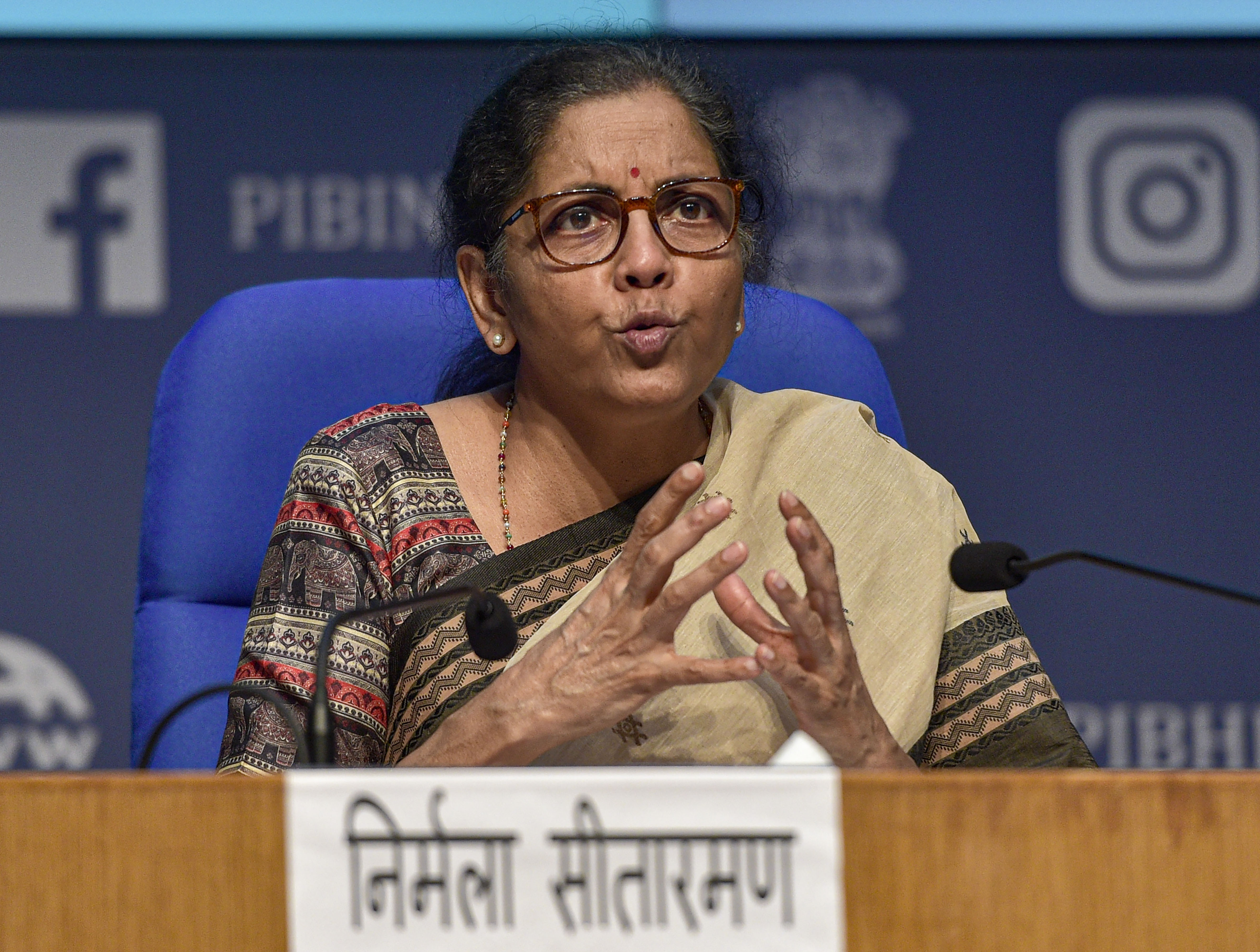Finance Minister Nirmala Sitharaman announced the fifth and final tranche of the government’s rescue package to boost the economy that has cratered on the back of the Covid-19 pandemic. But the announcement was panned by critics as being a recycled economic reform wish-list containing old promises that will do little to increase demand.
Sitharaman’s latest stimulus announcement covered a string of areas from MNREGA, health and education-related sectors to small business, ease of doing business and privatisation.
“In order to prove the resolve of the self-reliant India, land, labour, liquidity and laws, all have been emphasised in this package” called Atmanirbhar Bharat Abhiyan or Self-reliant India campaign, Sitharaman told reporters.
Critics say though that a large chunk of the stimulus measures announced to help India’s shrinking economy involve government-backed credit guarantee programmes that won’t worsen the already cash-strapped administration’s fiscal burden As far as increasing consumer demand, seen as the most urgent requirement to keep businesses afloat amidst the pandemic, the government’s done little to put cash in the hands of ordinary citizens, the critics say.
“The government has made a splash with its new support package... but as more details emerge, it is becoming increasingly clear that the package is rather less impressive than the headline figures would suggest,” said Capital Economics’ economist Shilan Shah. “The package will have limited impact on demand,” he said.
One of the harshest attacks has come from an India-wide India workers' group affiliated to the BJP's ideological mentor Rashtriya Swayamsevak Sangh (RSS). 'The impact of every change first falls adversely on employees. For employees, privatisation means massive job losses, below-quality jobs will be generated, ‘profitisation’ and exploitation will be the rule in the sector,” Bharatiya Mazdoor Sangh general secretary Virjesh Upadhyay said.
Rs 40,000 cr for rural job scheme
The finance minister earmarked an extra Rs 40,0000 crore for the MNREGA scheme on top of the Rs 61,000 crore contained in the budget estimate, saying the allocation will supply 300 crore more days of work for people and help address the job needs of returning migrants whose plight has been playing out on television screens for days.
Sitharaman also promised an increase in public spending on healthcare that is amongst the lowest in the world as a percentage of gross domestic product. She gave no numbers for the rise but said spending on rural and urban health and wellness centres would be hiked. She said the government was planning infectious disease hospital blocks in all districts and the establishment of public health laboratories at the block level.
Move to get India learning again
Sitharaman also gave a boost to technology-driven education through DIKSHA and promised the immediate start of the PM e-VIDYA programme enabling multi-mode access to digital and online education. There will be one TV channel targeting classes one to 12 along with wide use of community radio, podcasts and special e-content for those students with visual and hearing impairments. As part of the move to get India studying again, she said the country’s leading 100 universities can begin courses online at the end of May.
Relief in insolvency measures
The minister said that all-Covid related debts under the Insolvency and Bankruptcy Code will be excluded from default and no new insolvency proceedings can be launched for up to one year, up from the six months announced earlier by the government. For Micro, Small & Medium Enterprises (MSMEs), there will be a special insolvency framework that will lift the minimum threshold to initiate bankruptcy action to Rs 1 crore from Rs 1 lakh -- a move that should help “insulate” small businesses from going under, she said.
The government is also moving to reduce the logjam in criminal courts as well as cases before the National Company Law Tribunal. Sitharaman said the majority of compoundable offences sections under the Companies Act will be shifted to internal adjudicating mechanisms.
To assist public companies in raising finance, Sitharaman said they will be allowed to directly list securities in permitted foreign jurisdictions. She noted though that private companies which list non-convertible debentures on the stock exchanges will not be regarded as listed companies.
Privatisation push to PSUs
Sitharaman said that while public-sector enterprises will continue to play a key role in India’s economy, the country needs a system under which the private sector can participate in all sectors. She said one-to-four public sector companies will be involved in strategic sectors along with private sector firms. She said the government aims to privatise or merge public sector enterprises in non-strategic areas under holding companies to cut administrative costs.
She also announced a rise in borrowing limits for states from the Centre to help with Covid-19 costs. “Like the Centre, the state is also witnessing a sharp drop in revenues. Over Rs 46,038 crore were devolved as tax revenue to states. Over Rs 12,000 crore were also dispensed on time,” she said.
But while the Centre is hiking borrowing cap limits, business group Assocham said it calculates that the Union government and its agencies owe industry and state governments approximately Rs 3 trillion. The delay in payments by the Centre has left states urgently scrambling for funds.
During the previous days, Sitharaman announced India will open up its space facilities, mineral blocks and power distribution to private companies in a bid to drum up new investment for the economy. The government will also allow foreign investment up to 74 per cent in defence manufacturing through the automatic route. In addition, private companies will be allowed to use state-run space ports for launching satellites, open up airspace availability and privatise six more airports. There have also been loan guarantees for MSMEs and moves to ease strains on shadow banks and electricity distribution firms.
But “high levels of risk aversion mean that banks are still much more likely to park funds with the Reserve Bank of India than lend to the real economy,” noted Capital Economics’ Shah.










